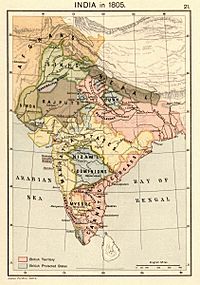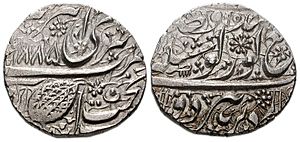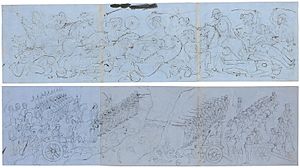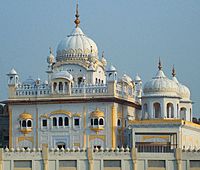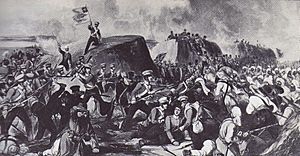Sikh Empire facts for kids
Quick facts for kids
Sikh Empire
سرکار خالصه
Sarkār-i-Khālsa ਖ਼ਾਲਸਾ ਰਾਜ Khālasā Rāj |
|||||||||||||||||||||
|---|---|---|---|---|---|---|---|---|---|---|---|---|---|---|---|---|---|---|---|---|---|
| 1799–1849 |
|||||||||||||||||||||
|
Flag
|
|||||||||||||||||||||
|
Motto: ਅਕਾਲ ਸਹਾਇ
Akāl Sahāi "With God's Grace" |
|||||||||||||||||||||
|
Anthem: ਦੇਗ ਤੇਗ ਫ਼ਤਿਹ
Dēġ Tēġ Fatih "Victory to Charity and Arms" |
|||||||||||||||||||||
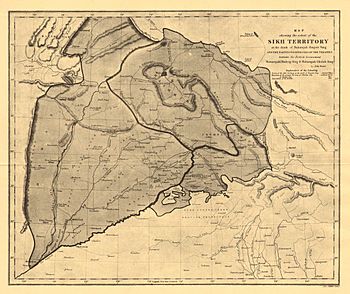
Sikh Empire at the death of Ranjit Singh in 1839
|
|||||||||||||||||||||
| Capital |
|
||||||||||||||||||||
| Court language | Persian | ||||||||||||||||||||
| Spoken languages | |||||||||||||||||||||
| Religion | |||||||||||||||||||||
| Government | Federal monarchy | ||||||||||||||||||||
| Maharaja | |||||||||||||||||||||
|
• 1801–1839
|
Ranjit Singh | ||||||||||||||||||||
|
• 1839
|
Kharak Singh | ||||||||||||||||||||
|
• 1839–1840
|
Nau Nihal Singh | ||||||||||||||||||||
| Regent | |||||||||||||||||||||
|
• 1840–1841
|
Chand Kaur | ||||||||||||||||||||
|
• 1843–1846
|
Jind Kaur | ||||||||||||||||||||
| Wazir | |||||||||||||||||||||
|
• 1799–1818
|
Khushal Singh Jamadar | ||||||||||||||||||||
|
• 1818–1843
|
Dhian Singh Dogra | ||||||||||||||||||||
|
• 1843–1844
|
Hira Singh Dogra | ||||||||||||||||||||
|
• 14 May – 21 September 1845
|
Jawahar Singh Aulakh | ||||||||||||||||||||
|
• 1845–1846
|
Lal Singh | ||||||||||||||||||||
|
• 31 January – 9 March 1846
|
Gulab Singh | ||||||||||||||||||||
| Historical era | Early modern period | ||||||||||||||||||||
|
• Capture of Lahore by Ranjit Singh
|
7 July 1799 | ||||||||||||||||||||
|
• End of Second Anglo-Sikh War
|
29 March 1849 |
||||||||||||||||||||
| Area | |||||||||||||||||||||
| 1839 | 520,000 km2 (200,000 sq mi) | ||||||||||||||||||||
| Population | |||||||||||||||||||||
|
• 1800s
|
12,000,000 | ||||||||||||||||||||
| Currency | Nanak Shahi Sikke | ||||||||||||||||||||
|
|||||||||||||||||||||
| Today part of | |||||||||||||||||||||
The Sikh Empire was a powerful state in the Punjab region of the Indian subcontinent. It began in 1799 when Maharaja Ranjit Singh took control of Lahore. The empire lasted until 1849, when it was defeated by the British in the Second Anglo-Sikh War.
This empire grew from different groups of Sikhs called Misls. At its largest, it stretched from Gilgit and Tibet in the north to the deserts of Sindh in the south. It also went from the Khyber Pass in the west to the Sutlej River in the east. The empire had four main areas: Lahore (the capital), Multan, Peshawar, and Kashmir.
The Sikh Empire was home to many different religions. In 1831, about 4.5 million people lived there. It was the last major part of India to be taken over by the British Empire.
The empire started when Ranjit Singh captured Lahore from its Afghan ruler. On April 12, 1801, he was declared the Maharaja of Punjab. This brought many smaller Sikh states together. Ranjit Singh also made his army stronger with modern training and weapons. After he died, the empire became weaker due to internal problems. The British East India Company also played a role in its decline. Finally, in 1849, the empire ended after losing the Second Anglo-Sikh War.
Contents
How the Sikh Empire Began
The Sikh Empire's beginnings can be traced back to 1707. This was when the Mughal Empire started to become weaker. As the Mughals lost power, the Sikh army, called the Dal Khalsa, grew stronger. This army was formed by Guru Gobind Singh.
The Dal Khalsa fought against both the Mughals and the Afghans. Over time, the army split into different groups called Misls. Each Misl controlled its own areas and cities. By the late 1700s, the leaders of these Misls became very independent.
Sikhs Under Mughal Rule
Sikhism started when the Mughal Empire was conquering North India. The Mughal emperor Akbar was friendly towards Sikhs. He visited their community kitchen (langar) and even gave them land. So, there were no major problems between Sikhs and Mughals until Akbar died in 1605.
However, Akbar's successor, Jahangir, saw Sikhs as a threat. He ordered Guru Arjan Dev to change parts of the Sikh holy book. When the Guru refused, Jahangir had him tortured and killed. This event, known as Guru Arjan Dev's martyrdom, deeply affected Sikhs.
The next Guru, Guru Hargobind, decided Sikhs needed to be strong. He built the Akal Takht (a central authority for Sikhs) and a fort to protect Amritsar. Jahangir jailed Guru Hargobind for a few years but later released him.
After Jahangir died in 1627, his son Shah Jahan continued to clash with Guru Hargobind. The Sikhs were forced to move to the Sivalik Hills. The next Guru, Guru Har Rai, kept the Sikh community safe in these hills.
Guru Tegh Bahadur, the ninth Guru, moved the community to Anandpur. He traveled widely to teach, even though Emperor Aurangzeb tried to stop him. Guru Tegh Bahadur helped Kashmiri Pandits (a Hindu group) avoid being forced to change their religion. Aurangzeb arrested him and offered him a choice: convert to Islam or die. Guru Tegh Bahadur chose death to protect his beliefs.
The Khalsa is Formed
Guru Gobind Singh became Guru in 1675. To avoid battles, he moved the Sikh center to Paunta. There, he built a large fort and an army to defend the city. The growing power of the Sikhs worried the local rulers in the Sivalik Hills. They attacked Paunta, but Guru Gobind Singh's forces defeated them.
He then moved back to Anandpur. On March 30, 1699, he created the Khalsa. This was a special army of Sikhs who had been baptized. The Khalsa united the Sikh community. In 1701, the Mughals and hill rulers attacked Anandpur. The Khalsa fought back bravely.
In 1707, Guru Gobind Singh met with Bahadur Shah I, Aurangzeb's successor.
Banda Singh Bahadur's Leadership
In 1708, Guru Gobind Singh met a man named Madho Das in Nanded. Madho Das became a Sikh and was renamed Banda Singh Bahadur. Before he died, Guru Gobind Singh asked Banda Singh Bahadur to take back the Punjab region. He also told all Sikhs to join him.
After two years, Banda Singh Bahadur started a rebellion. He broke up large land estates and gave the land to poor farmers. He defeated Mughal armies in several battles, including Samana and Sadhaura. He also defeated the Mughals at Sirhind. Banda Singh Bahadur destroyed cities where Mughals had been cruel to Sikhs. He executed Wazir Khan to avenge the deaths of Guru Gobind Singh's sons.
Banda Singh Bahadur ruled the area between the Sutlej river and the Yamuna river. He set up his capital in the Himalayas at Lohgarh. He also made coins in the names of Guru Nanak and Guru Gobind Singh. In 1716, his army was defeated by the Mughals at Gurdas Nangal. He and 700 of his men were captured and taken to Delhi. They were tortured and killed after refusing to convert to Islam.
The Sikh Empire's Story
The Dal Khalsa Period
The time from 1716 to 1799 was very unsettled in Punjab. The Mughal Empire was falling apart, leaving a power vacuum. The Sikhs of the Dal Khalsa (meaning "Khalsa army") eventually filled this gap.
Sikh Confederacy (Misls)
The Sikhs fought off many invasions by Afghan rulers and their allies. They also fought against the remaining Mughals and local Muslim forces. Over time, the Sikhs of the Dal Khalsa formed their own independent regions. These were called Misls. Each Misl was led by a Misldar. Maharaja Ranjit Singh later united most of these Misls.
Wars Between Misls
After Jassa Singh Ramgarhia, the Sikh Misls started fighting each other. This was like a 'Cold War' between different groups. For example, the Bhangi and Ramgharia Misls were against the Sukerchakia and Ahluwalia Misls.
Rani Sada Kaur of the Kanhaiya Misl became powerful. She weakened the Bhangi Misl. Later, she gave her power to Maharaja Ranjit Singh.
The Empire Forms
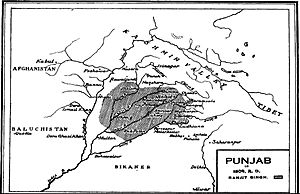
The Sikh Empire officially began in 1801. This is when Ranjit Singh united the different Misls into one political state. The Misl leaders, who were part of the army, became the nobility of the new empire.
The empire mainly covered the Punjab region. It stretched to the Khyber Pass in the west, Kashmir in the north, Sindh in the south, and Tibet in the east.
In 1799, Ranjit Singh moved the capital from Gujranwala to Lahore. His grandfather had established Gujranwala as the capital in 1763.
Ranjit Singh took over the Sial State in 1807. This was a local Muslim-ruled area. Its ruler, Ahmad Khan Sial, was secretly working with another ruler against Ranjit Singh.
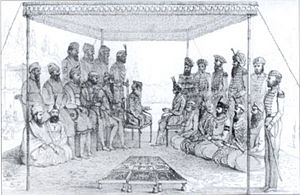
Hari Singh Nalwa was a very important general. He was the Commander-in-Chief of the Sikh Khalsa Army from 1825 to 1837. He helped conquer many areas like Kasur, Sialkot, Multan, Kashmir, Attock, and Peshawar. Nalwa also helped free Shah Shuja from Kashmir. This led to Maharaja Ranjit Singh getting the famous Koh-i-Nor diamond.
Hari Singh Nalwa also served as governor of Kashmir and Hazara. He set up a mint to collect taxes. He also expanded the Sikh Empire's border to the Indus River. When he died, the western border of the empire was the Khyber Pass.
The Namgyal dynasty of Ladakh paid yearly tribute to the Sikh Empire from 1819 to 1834. This tribute went to the Sikh governors in Kashmir. Later, the Dogras, who were under the Sikh Empire, conquered the Namgyal kingdom.
The Maqpon kingdom of Baltistan was conquered in 1839–40. Its ruler was removed from power.
During the Sino-Sikh war in 1841, the Sikh army invaded the Tibetan Plateau. This area was controlled by the Qing dynasty of China. However, the Sikhs had to retreat to Ladakh after a counterattack by Chinese and Tibetan forces.
Where the Empire Was Located
At its largest, the Sikh Empire covered over 200,000 square miles. Another estimate says it was about 100,436 square miles.
Today, parts of these modern countries were once part of the Sikh Empire:
- Punjab region, going south to Mithankot
- Punjab, Pakistan, except Bahawalpur State
- Punjab, India, except the Cis-Sutlej states
- Himachal Pradesh, India (areas northwest of the Sutlej river)
- Jammu Division, Jammu and Kashmir, India and Pakistan (1808–1846)
- Kashmir, from 1819 to 1846 (India/Pakistan/China)
- Kashmir Valley, India (1819 to 1846)
- Baltistan, from 1840
- Gilgit, Gilgit–Baltistan, Pakistan (1842 to 1846)
- Ladakh, India (1834–1846)
- Khyber Pass, Afghanistan/Pakistan
- Peshawar, Pakistan (taken in 1818, retaken in 1834)
- Khyber Pakhtunkhwa and Federally Administered Tribal Areas, Pakistan (from Hazara to Bannu)
- Parts of Western Tibet, China (briefly in 1841, to Taklakot)
Jamrud District was the westernmost point of the Sikh Empire. The Sikhs' expansion westward stopped at the Battle of Jamrud. In this battle, the Afghans killed the important Sikh general Hari Singh Nalwa. However, the Sikhs still held their fort at Jamrud. Ranjit Singh sent more troops to stop a rebellion there. In 1838, Ranjit Singh and his troops marched into Kabul. They joined the British in a victory parade after putting Shah Shoja back on the Afghan throne.
How the Empire Treated Different Religions
The Sikh Empire was special because it allowed people of different religions to hold important positions.
The Fakir brothers were close friends and advisors to Ranjit Singh. Fakir Azizuddin was the foreign minister and translator. He helped Ranjit Singh keep peace with the British in 1808. He also negotiated with Dost Muhammad Khan when he tried to retake Peshawar. The Fakir brothers were introduced to the Maharaja when their father, a doctor, treated Ranjit Singh's eye.
Other Fakir brothers, Imamuddin and Nuruddin, also held high positions. Imamuddin was a main administration officer. Nuruddin was the home minister and personal doctor.
Ranjit Singh respected all faiths. He visited shrines of Muslim saints every year in Amritsar. This did not bother even the most religious Sikhs.
Orders were given to treat everyone equally, no matter their religion or job. This was based on their religious laws, like the Shastras and the Quran. It was also forbidden to take someone's land or demolish their home by force. There were special courts for Muslims that followed Muslim law. Other courts used local customs and were open to Hindus, Sikhs, and Muslims.
After taking Lahore in 1799, Ranjit Singh brought back old Mughal positions. He appointed Muslim judges (Qazis and Muftis) to handle Muslim marriage issues and property transfers. A Muslim, Imam Bakhsh, was made the police chief (Kotwal).
Generals in the army also came from different backgrounds. There were Sikh generals like Hari Singh Nalwa. Hindu generals included Misr Diwan Chand and Dewan Mokham Chand Nayyar. Muslim generals included Ilahi Bakhsh and Mian Ghaus Khan. There were even European generals like Jean-Francois Allard.
Important jobs in the government and army were given based on skill and loyalty. People from all over the empire, including Sikhs, Muslims, Hindus, and Europeans, held these jobs. Dhian Singh Dogra, the prime minister, was a Dogra. His brothers also held high positions. Brahmins like Raja Dina Nath worked in finance.
Many Muslims held important roles. There were two Muslim ministers, one governor, and many district officers. In the army, 41 high-ranking officers were Muslim, including generals and colonels. More than half of the artillery soldiers were Muslim.
This mix of people made the Sikh Empire's government very diverse. It was almost like a secular system, even though it was based on Sikh principles.
One rule in the empire was a ban on killing cows. This was important to Hindu beliefs. Ranjit Singh also gave a lot of gold to plate the dome of the Kashi Vishwanath Temple.
Some people described the Sikhs as harsh rulers. While they were milder than the Afghans, some Muslim subjects felt unhappy. They disliked being ruled by non-Muslims. They also disliked the ban on killing cows and the ban on the azan (the Islamic call to prayer). Some historians say Sikh governors took over mosques and charged high taxes on Kashmiri Muslims. This caused a famine in 1832. Forced labor was also used to supply the army.
These policies caused many Kashmiri Muslims to move to other countries like Ladakh. As a show of power, Sikhs sometimes used Muslim places of worship for other purposes. For example, the Jamia Masjid in Srinagar was closed. The Badshahi Mosque in Lahore was used as a storage place for ammunition and horses. However, the empire still used Persian for official documents and court customs. Sikh silver coins were made like Mughal coins, with Persian writing.
Around 1839, Jewish refugees from Mashhad in Persia were allowed to settle in the Sikh Empire. They were escaping persecution in their homeland. Most of these Jewish families settled in Rawalpindi and Peshawar. Most of them left for India during the partition of 1947.
Christian missionaries were also active in Punjab before the empire ended in 1849.
How the Empire Was Organized
The Sikh Empire was divided into different provinces, called Subas. Here are some of them:
| No. | Name | Estimated population (1838) | Major population centre |
|---|---|---|---|
| 1. | Lahore Suba | 1,900,000 | Lahore |
| 2. | Multan Suba | 750,000 | Multan |
| 3. | Peshawar Suba | 550,000 | Peshawar |
| 4. | Derajat Suba | 600,000 | Dera Ghazi Khan, Dera Ismail Khan |
| 5. | Jammu and Hill States Suba | 1,100,000 | Srinagar |
People of the Sikh Empire
| Religions in Khalsa Empire (1800s) | ||||
|---|---|---|---|---|
| Religions | Percent | |||
| Islam | 69% | |||
| Hinduism | 24% | |||
| Sikhism | 6% | |||
| others | 1% | |||
During Ranjit Singh's rule, the Sikh Empire had about 12 million people. About 8.4 million were Muslims, 2.88 million were Hindus, and 722,000 were Sikhs.
Other estimates suggest that Sikhs made up about 10% to 12% of the population. Muslims were around 80%, and Hindus were just under 10%. One estimate from 1881 census data puts Muslims at 51%, Hindus at 40%, and Sikhs at about 8%.
Most of the Sikh population lived in certain fertile areas. These areas were around Lahore and Amritsar. In these core regions, Sikhs made up about one-third of the population in the 1830s.
How the Empire Ended
After Ranjit Singh died in 1839, the empire became very weak. There were many internal conflicts and poor leadership. The British East India Company saw this as an opportunity. They started the First Anglo-Sikh War.
The Battle of Ferozeshah in 1845 was a key moment. The Sikh army fought very well against the British. The Sikhs specifically targeted European soldiers in the British army. They believed this would break the enemy's spirit. The battle continued all night. The British faced heavy losses and were in a very difficult situation.
It is debated why the Sikhs withdrew from Ferozeshah. Some believe it was due to betrayal by non-Sikh leaders in their own army. Others think it was a smart tactical retreat.
The Sikh Empire finally ended after the Second Anglo-Sikh War in 1849. It was broken up into smaller states. The British then took direct control of the Punjab region. A British Governor was appointed in Lahore to represent the British Crown.
Important Dates in Sikh Empire History
- 1699: The Khalsa is formed by Guru Gobind Singh.
- 1710–1716: Banda Singh defeats the Mughals and declares Sikh rule.
- 1716–1738: A period of unrest; Mughals regain control, but Sikhs fight back.
- 1748–1757: Afghan ruler Ahmad Shah Durrani invades.
- 1761–1767: Afghans recapture Punjab in the Third Battle of Panipat.
- 1763–1774: Charat Singh Sukerchakia establishes power in Gujranwala.
- 1783: Sikhs capture Delhi and the Red Fort from the Mughals.
- 1773: Ahmad Shah Durrani dies; his son Timur Shah invades Punjab several times.
- 1774–1790: Maha Singh becomes leader of the Sukerchakia Misl.
- 1790–1801: Ranjit Singh becomes leader of the Sukerchakia Misl.
- 1799: The Sikh Khalsa Army is formed.
- April 12, 1801 – June 27, 1839: Reign of Maharaja Ranjit Singh.
- March – August 1809: Nepal–Sikh War.
- June 1, 1813: Ranjit Singh receives the Kohinoor Diamond.
- July 13, 1813: Battle of Attock, a big Sikh victory over the Durrani Empire.
- March – June 2, 1818: Battle of Multan, part of the Afghan–Sikh wars.
- July 3, 1819: Battle of Shopian.
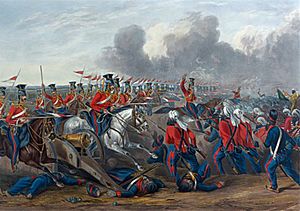
- March 14, 1823: Battle of Nowshera.
- April 30, 1837: Battle of Jamrud.
- June 27, 1839 – November 5, 1840: Reign of Maharaja Kharak Singh.
- November 5, 1840 – January 18, 1841: Chand Kaur is briefly Regent.
- January 18, 1841 – September 15, 1843: Reign of Maharaja Sher Singh.
- May 1841 – August 1842: Sino-Sikh war.
- September 15, 1843 – March 31, 1849: Reign of Maharaja Duleep Singh.
- 1845–1846: First Anglo-Sikh War.
- 1848–1849: Second Anglo-Sikh War.
Leaders of the Sikh Empire
| S. No. | Name | Portrait | Birth and death | Reign | Note | ||||
|---|---|---|---|---|---|---|---|---|---|
| 1 | Maharaja Ranjit Singh |  |
November 13, 1780 (Gujranwala) | June 27, 1839 (Lahore) | April 12, 1801 | June 27, 1839 | 38 years, 76 days | The first Sikh ruler | Died from a stroke |
| 2 | Maharaja Kharak Singh |  |
February 22, 1801 (Lahore) | November 5, 1840 (Lahore) | June 27, 1839 | October 8, 1839 | 103 days | Son of Ranjit Singh | Died from poisoning |
| 3 | Maharaja Nau Nihal Singh |  |
February 11, 1820 (Lahore) | November 6, 1840 (Lahore) | October 8, 1839 | November 6, 1840 | 1 year, 29 days | Son of Kharak Singh | Killed |
| 4 | Maharani Chand Kaur |
 |
1802 (Fatehgarh Churian) | June 11, 1842 (Lahore) | November 6, 1840 | January 18, 1841 | 73 days | Wife of Kharak Singh and the only female ruler of Sikh Empire | Stepped down |
| 5 | Maharaja Sher Singh |  |
December 4, 1807 (Batala) | September 15, 1843 (Lahore) | January 18, 1841 | September 15, 1843 | 2 years, 240 days | Son of Ranjit Singh | Killed |
| 6 | Maharaja Duleep Singh |  |
September 6, 1838 (Lahore) | October 22, 1893 (Paris) | September 15, 1843 | March 29, 1849 | 5 years, 195 days | Son of Ranjit Singh | Sent away |
| 7 | Maharani Jind Kaur (regent)(nominal) |
 |
1817 (Gujranwala) | August 1, 1863 (Kensington) | September 15, 1843 | March 29, 1849 | 5 years, 195 days | Wife of Ranjit Singh | Sent away |
Family Tree of Sikh Maharajas
| Family tree of the Maharajas of the Sikh Empire | |||||||||||||||||||||||||||||||||||||||||||||||||||||||||||||||||||||||||||||||||||||||||||||||||||||||||||||||||||||||||||||||||||||||||||||||||||||||||||||||||||||||||||||||||||||||||||||||||||||||||||||||||||||||||||||||||||||||||||||||||||||||||||||||||||||||
|---|---|---|---|---|---|---|---|---|---|---|---|---|---|---|---|---|---|---|---|---|---|---|---|---|---|---|---|---|---|---|---|---|---|---|---|---|---|---|---|---|---|---|---|---|---|---|---|---|---|---|---|---|---|---|---|---|---|---|---|---|---|---|---|---|---|---|---|---|---|---|---|---|---|---|---|---|---|---|---|---|---|---|---|---|---|---|---|---|---|---|---|---|---|---|---|---|---|---|---|---|---|---|---|---|---|---|---|---|---|---|---|---|---|---|---|---|---|---|---|---|---|---|---|---|---|---|---|---|---|---|---|---|---|---|---|---|---|---|---|---|---|---|---|---|---|---|---|---|---|---|---|---|---|---|---|---|---|---|---|---|---|---|---|---|---|---|---|---|---|---|---|---|---|---|---|---|---|---|---|---|---|---|---|---|---|---|---|---|---|---|---|---|---|---|---|---|---|---|---|---|---|---|---|---|---|---|---|---|---|---|---|---|---|---|---|---|---|---|---|---|---|---|---|---|---|---|---|---|---|---|---|---|---|---|---|---|---|---|---|---|---|---|---|---|---|---|---|---|---|---|---|---|---|---|---|---|---|---|---|---|---|---|---|
|
|||||||||||||||||||||||||||||||||||||||||||||||||||||||||||||||||||||||||||||||||||||||||||||||||||||||||||||||||||||||||||||||||||||||||||||||||||||||||||||||||||||||||||||||||||||||||||||||||||||||||||||||||||||||||||||||||||||||||||||||||||||||||||||||||||||||
Images for kids
-
Ranjit Singh listening to Guru Granth Sahib being recited near the Akal Takht and Golden Temple, Amritsar, Punjab, India. -
A letter sent from the King of France, Louis-Philippe to Maharaja Ranjit Singh. Ranjit Singh is addressed as “Rendjit Sing Bahador - Padichah du Pendjab”. Dated October 27, 1835.
| Preceded by Sukerchakia Misl |
Sikh Empire 1799–1849 |
Succeeded by East India Company |
See also
 In Spanish: Imperio sij para niños
In Spanish: Imperio sij para niños
- History of Punjab
- History of Pakistan
- History of India
- Kapurthala State
- Mughal Empire
- Sikh Khalsa Army



